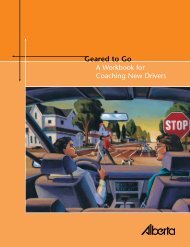Commercial driver's guide to operation, safety and licensing
Commercial driver's guide to operation, safety and licensing
Commercial driver's guide to operation, safety and licensing
You also want an ePaper? Increase the reach of your titles
YUMPU automatically turns print PDFs into web optimized ePapers that Google loves.
• Even during the most serious emergency,<br />
an emergency medical opera<strong>to</strong>r must<br />
consider the <strong>safety</strong> of others.<br />
• When parking an emergency vehicle,<br />
the law states:<br />
··<br />
Where, considering the<br />
circumstances, it is reasonable <strong>and</strong><br />
safe, an emergency vehicle may,<br />
while its flashing lights are operating,<br />
be parked contrary <strong>to</strong> any provision<br />
that is prescribed by the Act, this<br />
or other regulations or a municipal<br />
bylaw governing the parking of<br />
mo<strong>to</strong>r vehicles.<br />
Defensive driving<br />
fac<strong>to</strong>rs<br />
Headlights<br />
Always use headlights along with the<br />
emergency overhead lights.<br />
Lights <strong>and</strong> sirens<br />
Sirens are required by law when an<br />
ambulance is operating during an<br />
emergency. Using the red flashing<br />
overhead lights alone is not sufficient. Do<br />
not let the emergency sirens <strong>and</strong> lights<br />
give you a false sense of security. These<br />
warning devices are for the benefit of the<br />
public. Most drivers will clear the path if<br />
they know the ambulance is there. Do not<br />
assume that other drivers have seen your<br />
vehicle or that they will move out of the<br />
way. The responsibility for safe driving rests<br />
on you, the emergency vehicle driver.<br />
Other fac<strong>to</strong>rs<br />
As an emergency medical opera<strong>to</strong>r, it<br />
is important <strong>to</strong> identify those situations<br />
that could result in a collision. Driving<br />
movements that can contribute <strong>to</strong><br />
collisions are:<br />
• reversing<br />
• poor road position<br />
• turning<br />
• changing lanes<br />
• lack of awareness of the unit size that<br />
can lead <strong>to</strong> side swipes on the blind<br />
right side<br />
• driving <strong>to</strong>o fast for conditions<br />
If you approach an intersection with<br />
cross traffic, slow down <strong>and</strong> if practical,<br />
s<strong>to</strong>p briefly. Make eye contact with the<br />
other drivers at the intersection <strong>and</strong><br />
proceed when you have been seen by<br />
them. Be even more careful at pedestrian<br />
crossings. Many pedestrians, including<br />
school children, may not be aware that an<br />
ambulance is coming <strong>to</strong>ward them.<br />
If you are driving on a four-lane highway<br />
with the lights <strong>and</strong> siren activated, stay in<br />
the left lane if possible.<br />
When reaching the scene of a collision,<br />
park the vehicle so it protects the injured<br />
person(s) <strong>and</strong> the attendant. Keep the<br />
flashing lights activated <strong>and</strong> turn on the<br />
headlights so that the vehicle is clearly<br />
visible <strong>to</strong> other drivers.<br />
Operating a taxi<br />
As the driver of a taxi, your first <strong>and</strong> most<br />
important concern is <strong>safety</strong>. You will<br />
encounter numerous challenges in the<br />
driving task, <strong>and</strong> will need <strong>to</strong> be aware<br />
CHAPTER SEVEN Operating Class 4 vehicles 67




